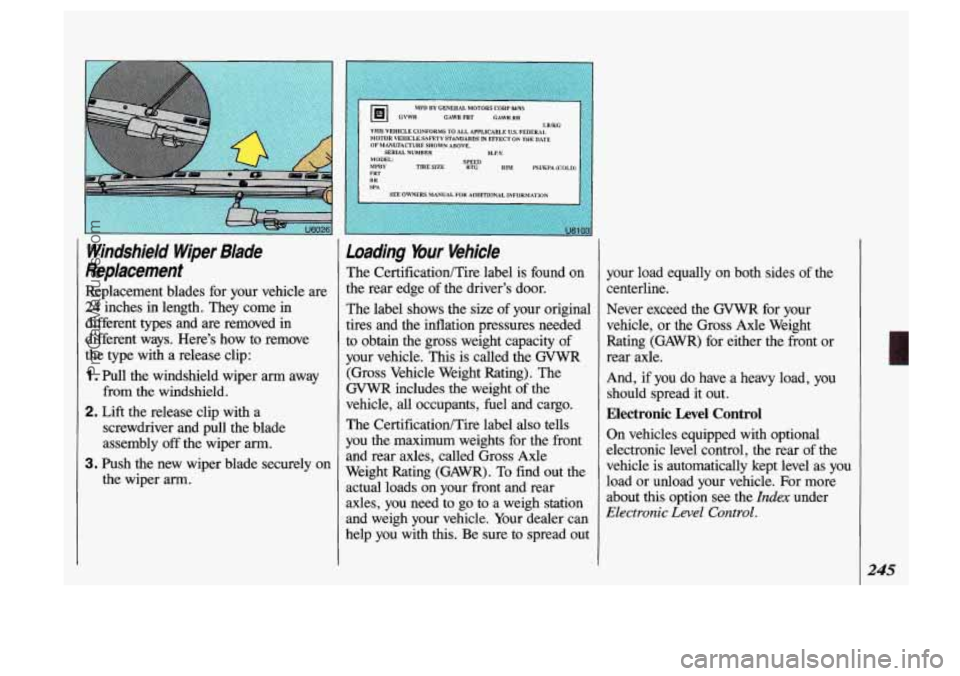Page 247 of 323

Windshield Wiper Blade
Replacement
Replacement blades for your vehicle are
24 inches in length. They come in
different
types and are removed in
different ways. Here's how to remove
the type with a release clip:
1. Pull the windshield wiper arm away
from the windshield.
2. Lift the release clip with a
screwdriver and pull the blade
assembly
off the wiper arm.
the wiper arm.
3. Push the new wiper blade securely on
CAWRFRT GAWRRR
THIS MH1CX.E CONNJRMS TU ALL APPLICABLE US FEDERAL
OF MANUFACWRE SHOWN ABOVE. MOTOR YWICLE SAFETY SPANDARDS lN EFFECT ON TAe DAn
SERIAL MlMBBR
TIRESIZE '%ED RIM PSYKPA(C0LD)
Loading Mur Vehicle
The CertificatiodTire label is found on
the rear edge of the driver's door.
The label shows the size
of your original
tires and the inflation pressures needed
to obtain the gross weight capacity of
your vehicle. This is called the
GVWR
(Gross Vehicle Weight Rating). The
GVWR includes the weight of the
vehicle,
all occupants, fuel and cargo.
The CertificatiodTire label also tells
you the maximum weights for the front
and rear axles, called Gross Axle
Weight Rating (GAWR). To find out the
actual loads on your front and rear
axles, you need to go to a weigh station
and weigh your vehicle. Your dealer can
help you with this. Be sure to spread out your load equally on both sides
of the
centerline.
Never exceed the
GVWR for your
vehicle, or the Gross Axle Weight
Rating (GAWR) for either the &ont or
rear axle.
And, if you do have a heavy load, you
should spread
it out.
Electronic Level Control
On vehicles equipped with optional
electronic level control, the rear of the
vehicle
is automatically kept level as you
load or unload your vehicle. For more
about
this option see the Index under
Electronic Level Control.
L
245
ProCarManuals.com
Page 248 of 323

Service & Appearance Care
246
Loading Your Vehice (CONTI
I I
Do not load your vehicle any
L heavier than the GVWR or the
aximum front and rear GAWRs.
If you do, parts on your vehicle
can break, or
it can change the way
your vehicle handles. These could
cause you to lose control. Also,
overloading can shorten the life of
your vehicle.
Using heavier suspension components to
get added durability might not change
your weight ratings. Ask your dealer to
help you load your vehicle
the right way.
-r componenk that fhil because o
verloabing. .. .. .,... . - .. ,l_, ._, ,
It you put things inside your vehicle-
like suitcases, tools, packages, or
anything else-they will go as fast as
the
vehicle goes. If you have to stop or turn
quickly, or if there is a crash, they'll
keep going. I
A vehicle can strike and injure
+ople in a sudden
stop or turn, or
in a crash.
Put things in the cargo area of
xInl1r vehicle. Try to spread the
. . ight evenly.
Never stack heavier things, like
suitcases, inside the vehicle so
that some of them are above the
tops
of the seats.
When you carry something
inside
the vehicle, secure it
whenever you can.
Don't leave a seat folded down
unless you need to.
ProCarManuals.com
Page 255 of 323

Used Replacement Wheels Tire Chains
Using the wrong replacement
b wheels, wheel bolts, or wheel
nuts on your vehicle can be
dangerous. It could affect the
braking and handling
of your
vehicle, make your tires lose air
and make you lose control. You
could have a collision in which you
)r others could be injured. Always
lse the correct wheel, wheel bolts,
1 and wheel nuts for replacement.
IL
The wrong wheel can also cause
problems with bearing life, brake cooling, speedometer/odometer
calibration, headlight aim, bumper
height,
vehicle ground clearance,
adtire
or tire chain clearance to
.the-body
.~ and chassis,;f,;,ir, ~ ~~~ .. .~. ..~ = ~ ~=.=.=~~~~ ... ~~
Putting a used wheel on your
vehicle is dangerous. You
can t
know how it’s been used or
how many miles it’s been driven. It
-ould fail suddenly and cause an
,ccident. If
you have to replace a
wheel, use
a new GM original
equipment wheel.
e
Use tire chains only when y
must. Use only SAE Class ‘23’’
type chains that are the proper size
for your tires. Install them on the
front tires and tighten them as
tightly as possible with the ends
securely fastened. Drive slowly
and follow the chain manu-
facturer’s instructions. If
you can
hear the chains contacting your
vehicle, stop and retighten them.
If
the contact continues, slow down
until it stops. Driving too fast with chains on will damage your
vehicle.
:l I ’
I
. .. ..
253
ProCarManuals.com